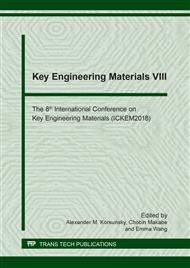p.217
p.224
p.231
p.238
p.246
p.254
p.260
p.266
p.272
Electrical Properties of Nanostructure n-ZnSe/p-Si(100) Heterojunction Thin Film Diode
Abstract:
The ZnSe/Si heterojunction is of specific interest since this structure provides effective solar cell and enables the integration of wide bandgap device in silicon circuits. It is known that the quality of the diode and the current transport mechanisms across the heterojunction may be greatly influenced by the quality of the interface and depends on the crystallinity of the film layer. In this work, n-ZnSe/p-Si (100) heterojunction was fabricated by thermal evaporating ZnSe thin films on p-Si (100) substrates. The current-voltage characteristics of n-ZnSe/p-Si (100) heterojunction were investigated in temperature range 20-300 K. Some important parameters such as barrier height, ideality factor and series resistance values evaluated by using thermionic emission (TE) theory and Cheung’s method at room temperature are n = 2.910, φB0 = 0.832 eV and 8.59103 Ω, respectively. The temperature dependence of the saturation current and ideality factor are well described by tunneling enhanced recombination at junction interface with activation energy and characteristic energy values about 1.293 eV and E00 = 95 meV, respectively. The carrier concentration of ZnSe thin films about 3.16×1013 cm-3 was deduced from the C-V measurements at room temperature. Admittance spectroscopy was employed for analysis of the defect energy levels situated in depletion region. The results showed that there was a single trap level whose position in the band gap was close to 0.04 eV above valence band. The results of this work may be useful for application such as heterojunction solar cells.
Info:
Periodical:
Pages:
246-253
Citation:
Online since:
August 2018
Authors:
Price:
Сopyright:
© 2018 Trans Tech Publications Ltd. All Rights Reserved
Share:
Citation:


